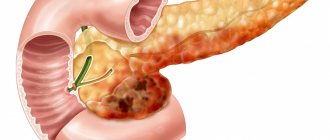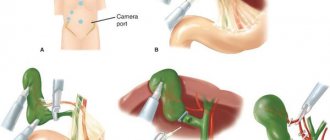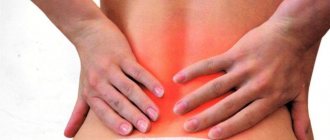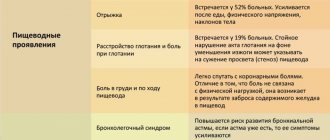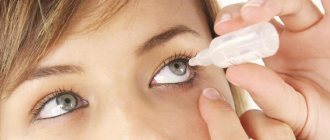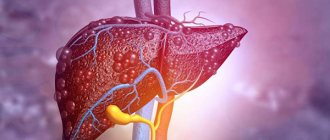Author Andrey Mikhailov
10/25/2002 13:39 (Updated: 07/02/2021 14:25)
Health
Statistics show that pancreatitis has become a very common disease in recent years. For example, in our country there are 27.4–50 cases of chronic pancreatitis per 100,000 people, and the picture is approximately the same in European countries. The number of patients suffering from the acute form of the disease is also increasing: in Russia, the frequency of cases ranges from 10 to 13% of the total number of patients with surgical pathologies of the abdominal organs.
Pancreatitis: types, causes and symptoms of the disease
In medicine, pancreatitis is defined as an inflammatory disease of the pancreas - one of the most important human organs, responsible for the production of digestive juice and playing a key role in the entire process of digestion and absorption of food.
According to the classification, there are several main forms of pancreatitis:
- Acute pancreatitis , in which the activation of digestive enzymes in the pancreas itself occurs, as a result of which its tissues are affected - “self-digestion” of the organ occurs, accompanied by swelling and necrosis of cells, as well as possible damage to surrounding tissues and organs. The causes of acute pancreatitis can be diseases of the bile ducts (35%), abdominal trauma, poisoning, and severe allergic reactions. But one of the main factors provoking the disease is alcohol abuse (55% of cases are caused by this very reason).
- Acute recurrent pancreatitis resembles a mild form of acute pancreatitis, but is characterized by repeated attacks of varying degrees of intensity. This form is very difficult to diagnose.
- Chronic pancreatitis (CP) is an independent, slowly progressive disease of the pancreas, which is characterized by alternating periods of exacerbations and remissions. Traditionally, alcohol abuse is also considered one of the main reasons for the development of CP (60–70%). In addition, the disease can also be caused by an unhealthy diet with a predominance of fatty and spicy foods, which provokes excessive stress on the pancreas. Sometimes CP occurs as a result of the spread of a stomach or duodenal ulcer to the gland. There are two main stages of the disease. The first can last several years, while the patient is practically not bothered by anything. This stage, without proper treatment, will inevitably progress to the next, at which the damage to the organ turns out to be very serious, symptoms appear constantly and periods of exacerbation often occur.
Acute and chronic pancreatitis in the acute stage is characterized by three common symptoms:
- sharp and severe pain in the upper abdomen, girdling the body or radiating to the back,
- profuse vomiting that does not bring relief,
- and tension in the muscles of the upper abdomen, revealed during the examination.
Any form of pancreatitis sooner or later leads to pancreatic enzyme insufficiency, in other words, a lack of digestive enzymes.
Symptoms of enzyme deficiency in pancreatitis are usually very pronounced - this
- flatulence,
- heartburn,
- nausea,
- polyfecal.
One of their characteristic signs is the presence of undigested lumps of food and a large amount of fat in the feces. This happens due to the fact that the digestive system cannot cope with the digestion of food, which remains in the intestinal lumen and irritates it, while the flow of nutrients into the blood is significantly reduced. Due to poor absorption of nutrients, the patient eventually develops vitamin deficiency, anemia and, as a result, general exhaustion of the body.
Where did he come from?
Pancreatitis can be caused by a birth defect in the pancreas, certain autoimmune diseases, or certain medications. The disease can be triggered by a number of infections, hepatitis B or mumps. But most often, inflammation of the pancreas is caused by alcohol abuse.
Alcohol itself has a bad effect on gland cells, causing their damage. In response to a “drink or two,” the concentration of enzymes in the digestive juice increases. It moves more slowly along the ducts and therefore can begin to act before reaching its destination. Moreover, alcohol causes spasm of the sphincter located between the pancreas and duodenum. Normally, it should allow enzymes into the intestines, but block the exit of digested food from it. After abusing alcohol, it may not open in time, blocking digestive juice in the ducts.
Scientists have calculated that in order to “earn” pancreatitis, a person must consume 150 g of alcohol daily in terms of pure alcohol for 10 years. This is 375 g of vodka, about 1 liter of wine or 3 liters of beer. Quite a lot. However, let's not forget: these are averages. For many, the reaction occurs faster. For some, it is enough to “abuse” just a few times to provoke an attack.
The most dangerous combination of alcohol with fatty, spicy, salty foods. That is why the maximum number of exacerbations occurs after the holidays, when we lean on alcohol and delicacies. Such food in itself is dangerous: doctors attribute the fact that the incidence of pancreatitis has been constantly increasing in recent years to the increase in consumption of fatty foods.
Another cause of an attack may be gallstone disease. If you draw a schematic diagram of the bile duct and pancreatic duct, they will look like rivers on a map. Both “streams” flow into the “sea” - the duodenum. In a small area in front of it, they “merge” together, forming a common channel. If a stone travels along the bile duct and gets into this part, it can block the “gate” to the pancreas, thereby causing stagnation of enzymes.
Article on the topic
The pancreas takes revenge on us for our mistakes
What can cause exacerbation of chronic pancreatitis?
Chronic pancreatitis is an insidious disease; a person can live peacefully and not feel symptoms for a long time. But what plays the role of a “trigger” in the transition of the disease to the exacerbation phase? The same reasons that cause the development of the disease itself.
- Firstly, an acute attack of pancreatitis occurs due to a violation of the diet. Overeating, especially if the regular menu contains a large number of spicy and fatty foods, fast food, smoked meats and canned food, inevitably leads to excessive stress on the diseased organ.
- Secondly, this is the same frivolous attitude towards alcohol - drinking alcohol even in relatively small doses can transfer the disease to an acute stage.
- Thirdly, the impetus can be intoxication due to acute respiratory viral infections or taking certain medications: chronic patients should be careful about any drug therapy, especially if it was not prescribed by a doctor.
- Fourthly, some autoimmune diseases (for example, cystic fibrosis), physical fatigue or chronic stress can trigger the onset of an attack of pancreatitis.
The first and main signal about the onset of an attack of pancreatitis is the appearance of acute pain in the epigastric region, sometimes radiating to the back or the heart area - this symptom is typical for 80–90% of all patients. After eating, the pain usually increases; it can be reduced by sitting or bending forward. Sometimes the pain cannot be eliminated by taking painkillers, and as its intensity increases, even painful shock and loss of consciousness are possible.
Pain during exacerbation of pancreatitis may appear an hour or two after eating fatty or spicy foods. It happens that an attack of pancreatitis begins later - after 6-12 hours. An even longer “delay” is often observed after alcohol abuse - it can reach two or even three days. In medical practice, there have been cases of the onset of an attack in the next few minutes as a result of drinking cold fizzy drinks. In some cases, pain has no obvious connection with food intake at all.
As chronic pancreatitis worsens, the patient develops
- specific bitterness in the mouth,
- whitish coating on the tongue,
- loss of appetite,
- nausea,
- vomiting that does not improve the patient’s well-being.
Nutrition in the acute phase
In addition to knowing how to relieve an attack of pancreatitis at home, you need to learn some nutritional rules. By following a certain diet, you can smooth out the clinical manifestations of acute pancreatitis and reduce the frequency and duration of exacerbation phases.
Principles of proper nutrition during illness:
- exclusion of foods containing fats, carbohydrates (especially sugar and foods containing it);
- increasing the volume of products with lean proteins;
- exclusion of fried, fatty, coarse fiber;
- maintaining fractional meals (small portions, but often throughout the day).
For pancreatitis, it is important to consume many vitamins and beneficial micro- and macroelements, and since it is difficult to get them all from food, doctors recommend taking synthetic drugs.
In the acute stage of pancreatitis, foods (except those prohibited) must be crushed before consumption, boiled or steamed. Frying is prohibited.
Diet in the first and subsequent days
During the first two days of exacerbation of the disease, a person is prohibited from eating. It is only permissible to drink mineral water (not carbonated). This helps to suppress the secretion of pancreatic juice, reduce the intensity of pain, and remove toxic substances and breakdown products from the body. Mineral water can be replaced with rosehip decoction.
On the third day, the diet can be diversified by including ground food. The following foods should not be included in the diet:
- salt-containing;
- fats and carbohydrates;
- coarse fiber;
- hot seasonings, smoked meats, spices;
- marinades, onions, garlic;
- baking;
- alcohol.
After reducing the intensity of inflammatory manifestations, you can eat puree soup, lean meats, fish, cottage cheese, cereals and vegetables (in addition to cabbage, which increases gas formation). You can drink fruit and vegetable juice, fermented milk products (yogurt, kefir, etc.).
How long the diet will last depends on the characteristics of the development of the disease. The average duration is 6-12 months.
How long does an attack of chronic pancreatitis last?
To accurately answer the question “How long does an attack of pancreatitis last?” difficult - from an hour to several days, and the period of exacerbation of pancreatitis with regularly recurring attacks - from a week or more.
It is impossible to treat an exacerbation on your own: according to statistics, approximately 15–20% of patients die from complications that arose during an attack. When it starts, you should immediately call an emergency medical team, and before it arrives, it is recommended to follow a few simple recommendations to slightly alleviate the patient’s condition.
Unconventional treatment
During the acute stage, treating pancreatitis with non-traditional methods is inappropriate due to their ineffectiveness. However, in the remission phase, they help reduce the intensity of the inflammatory process, thereby reducing the duration and frequency of exacerbations.
You should immediately take into account that folk remedies will have to be taken for a long time and on an ongoing basis. Medicinal herbs are used as a basis:
- pharmaceutical camomile:
- immortelle;
- thyme;
- yarrow;
- plantain;
- celandine.
Infusions and decoctions are made from herbs, which are taken orally instead of tea throughout the day. The following folk remedies will also be effective:
- drinking potato juice in its pure form (50 ml per day);
- preparing medicinal porridge: pour raw buckwheat with kefir, leave to infuse overnight, take in the morning instead of breakfast;
- use of oatmeal jelly: soak the flakes in water for half an hour, add water and boil for an hour until a thick consistency is obtained.
Despite the fact that alternative medicine products have a natural composition and do not contain synthetic components, even these can cause harm to the body if used incorrectly.
In addition to being accompanied by severe symptoms, attacks of pancreatitis can be complicated by negative consequences. Therefore, it is not enough to take painkillers. Treatment of the disease must be comprehensive.
First aid for an attack of pancreatitis
The first aid formula is simple - “cold, hunger and rest.” During an attack, a patient needs to be provided with all three of its components as soon as possible:
- completely exclude the intake of any food and liquids (except for clean, cool water) in order to relieve the load on the pancreas - this ban will remain in effect until the person’s condition returns to normal;
- put the patient in bed on his back; if vomiting, it is permissible to take a position on his side with his knees pressed to his stomach;
- apply a cold compress to the pancreas area.
In this case, it is prohibited to take medications on your own - competent assistance for exacerbation of pancreatitis can only be provided by a doctor in a hospital setting. It is there that the patient will undergo an examination, and based on a set of diagnostic measures, he will be prescribed adequate therapy.
This complex includes
- palpation,
- laboratory diagnostics, including a detailed clinical, biochemical blood test and bacteriological examination of abdominal exudate (performed during surgery),
- enzyme research and instrumental diagnostics - ultrasound of the abdominal organs,
and according to indications -
- MRI,
- computed tomography (radiography).
During treatment, severe pain is relieved with the help of analgesics and antispasmodics, the latter are also necessary to restore the normal outflow of pancreatic juice. If an infection is detected or during surgery, antibacterial drugs are prescribed. To reduce pancreatic activity, it is possible to prescribe somatotropin antagonists. According to indications, gastric contents are pumped out and intensive detoxification therapy is carried out.
During the period of exacerbation of pancreatitis, the use of enzyme preparations is contraindicated.
To correct changes in the patient’s body, appropriate symptomatic treatment is used, which may include drugs that support heart function, normalize blood pressure, and others.
If a patient develops necrosis of pancreatic tissue—pancreatic necrosis—an operation is performed to remove it.
Treatment methods for acute pancreatitis
The result of treatment of acute pancreatitis largely depends on the timely initiation of therapy. In most cases, antibiotics are immediately prescribed; drug treatment is indispensable. If acute pancreatitis occurs with complications, nausea, vomiting, problems with stool, increased body temperature appear, and hospitalization is required.
Treatment of the acute form of the disease can be effectively supplemented by the use of folk remedies, but they cannot be the main therapy.
The following effective recipes are popular:
- Triple tincture . Many adults are satisfied with the use of the tincture. To prepare it, take 100 g of onion, chop it, pour in 0.5 liters of vodka, then the same amount of walnut leaves and mantle grass. Three products are infused separately, then mixed: 150 ml of onion, 50 ml of nut and herbal. The triple tincture should be taken one tablespoon on an empty stomach and before bedtime.
Important! The product is based on vodka, so it is not suitable for everyone; it is strictly prohibited in the treatment of acute pancreatitis for children.
- Lemon with parsley, garlic . It is necessary to prepare the product in advance; it infuses for about a week, so it is not always possible to do this. However, it is highly effective; some people prepare it and start taking it immediately. Take 1 kg of lemons, pass through a meat grinder (without peeling), then chop 250 g of parsley root and garlic, mix, place in a glass jar. Take the product one teaspoon before meals.
- The following recipe is used in the morning: take raw egg white , beat, gradually adding the juice of half a lemon. The drug is drunk on an empty stomach, preferably after waking up, so that at least an hour passes before breakfast.
What can be done after an exacerbation of pancreatitis
After an attack of pancreatitis is relieved, treatment should be aimed primarily at supporting the function of the pancreas and its ability to fully digest food entering the body. The pancreas is not capable of self-healing, which means it cannot work without support during chronic pancreatitis. That is why one of the main directions of treatment during remission is enzyme therapy - the same one that is not allowed during exacerbation of the disease.
Enzyme replacement therapy is not capable of restoring the pancreas, but can take over some of its functions. The corresponding enzyme preparations are prescribed for a long time, sometimes for life - with their help, the human body fully receives all the nutrients it needs from food.
But this is not the only function of enzyme-containing drugs: their ability to relieve pain itself and minimize the secretory function of the pancreas, providing it with functional rest, has been proven. This ability is realized through the mechanism of reverse inhibition of enzyme production.
In addition to enzyme therapy, the patient is prescribed a special diet, which also reduces the load on the affected organ. It is recommended to refuse
- animal fats,
- sour, fried, salty, smoked foods,
- strong broths and soups based on them.
And, of course, they fall under a complete ban
- alcohol
- and smoking.
Relieving attacks in chronic pancreatitis and especially the subsequent prevention of pancreatic insufficiency require long-term and well-coordinated collaboration from the doctor and the patient. Self-medication in this case can easily lead to serious complications that can be life-threatening.
Pancreatitis: treatment + diet. Effective treatment of the pancreas without drugs or with drugs
Curator: Marina Chizhikova, Elena Enenkova, Alla Ponomareva
Themes
Prevent trouble
Rare and moderate alcohol consumption, a healthy diet, and physical activity are enough to keep the pancreas healthy. And one more thing: if you don’t want to get sick, quit smoking. All other things being equal, pancreatitis occurs in heavy smokers approximately 5 years earlier than in non-smokers. And the risk of developing tumors in the pancreas in smokers is 2-3 times higher.
It is necessary to follow all these rules even if an attack has already occurred. After it is removed, you will have to add a diet to everything else. From the diet you need to exclude everything fatty, fried, spicy, rich broths, smoked foods, soda and alcohol. You will also have to give up salt, milk, pure sugar, honey and jam for a while. Among the prohibited vegetables are cabbage, legumes, spinach and radishes. But soups and purees from other vegetables are welcome. Meat and fish should be low-fat varieties: lean beef, chicken fillet, turkey, pike perch, carp. Vegetables can only be consumed boiled or steamed and preferably pureed. Fruits – baked, in the form of jelly or compote. An important component of the diet should be well-cooked porridge, for example, buckwheat or oatmeal. Fermented milk products are allowed, but they should not be too sour. It is necessary to sit down at the table often and eat little by little. All these rules will help to avoid repeated attacks and maintain health.
Specialists
| 5.0 137 reviews | Chizhikova Marina Dmitrievna Gastroenterologist Experience 31 years Doctor of the highest category Admission from 3300 rub. |
| 5.0 139 reviews | Enenkova Elena Alekseevna Gastroenterologist Experience 33 years Doctor of the highest category Admission from 2400 rub. |
| 4.9 126 reviews | Ponomareva Alla Vasilievna Gastroenterologist Experience 36 years Doctor of the highest category Admission from 2500 rub. |
Antispasmodics and analgesics
Painkillers “No-shpa”, “Papaverine”, “Baralgin” are welcome and considered necessary in the home medicine cabinet. The drugs are effective and safe. They eliminate spasm of smooth muscles and reduce pain. Sometimes they take analgesics: Paracetamol, Aspirin. In some cases, to prevent the development of allergic reactions, antihistamines are used: Atropine, Platifillin, Diphenhydramine.
H2 blockers
H2 blockers (Famotidine, Ranitidine, Cimetidine) are used to suppress pancreatic secretion. Sometimes hormones are prescribed that inhibit the acid-forming function of the stomach (Somatostatin, Glucagon). The use of such drugs is justified in pancreatic shock.
Enzyme preparations
To normalize digestion and better assimilate proteins, fats and carbohydrates, enzyme substances are used, including amylase, lipase, protease. Enzyme preparations are available without a doctor's prescription; popular products are: “Creon”, “Pancreatin”, “Festal”.
If a person is allergic to pork protein, herbal preparations are used: Somilase, Pepfiz. Enzymes are prescribed by your doctor and taken after meals. The duration of treatment depends on the form and degree of development of the inflammatory process, the age of the patient, and concomitant diseases.
Antacids
Antacids are used to neutralize and reduce the production of hydrochloric acid. The most commonly used are Almagel, Phosphalugel, Gastrozol, and Controloc. The medication is taken 1 hour after meals. It is not advisable to use it together with other medications.
